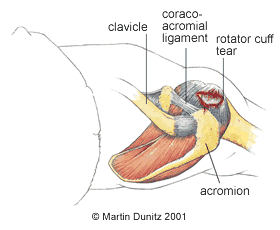Rotator Cuff Calcific Tendonitis in Depth
AKA: Calcific Tendinopathy
| Common Signs & Symptoms | |||||
| Pain | Swelling | Stiffness | Weakness | Instability | Locking |
Rotator Cuff Calcific Tendonitis Injury Explained
Rotator Cuff Calcific Tendonitis is a fairly common cause of shoulder pain, which is difficult to distinguish from rotator cuff tendonitis or a torn rotator cuff. The cause of this relatively common shoulder problem is not fully understood. As the name suggests, Rotator Cuff Calcific Tendonitis is characterised by calcific deposits in the rotator cuff tendons of the shoulder.
The rotator cuff consists of the Supraspinatus, Infraspinatus, Teres minor and Subscapularis muscles and tendons. Their role is to carry out rotational movements around the shoulder and increase the stability of the ball and socket joint. The Supraspinatus tendon is most commonly affected although some people can suffer calcific deposits in several tendons.

The pathology of this condition is divided into three phases:
- The first phase is the ‘Pre-calcific’ stage, which consists of thinning of tendon fibres, with a change in this tissue to fibrocartilage. This is thought to be due to repeated damage to the tendon due to overuse.
- This is followed by the ‘Calcific’ stage. Here, calcium crystals are deposited within the tendon, which has a chalk like appearance. These calcium crystals are derived from calcium circulating within the blood.
This calcific material is usually spontaneously re-absorbed as a material which resembles toothpaste. - Once fully re-absorbed, there follows a ‘Post calcific’ stage, where scar tissue is laid down in the space that the calcific material had occupied.
Rotator Cuff Calcific Tendonitis Signs & Symptoms
An acute rotator cuff Rotator Cuff Calcific Tendonitis can cause exquisite shoulder pain that can radiate to the neck and down the arm. During the acute phase, this is irritated by all shoulder movements. In more chronic Rotator Cuff Calcific Tendonitis, the most common finding is shoulder pain at night. This pain is difficult to localise and covers a diffuse area over the shoulder region.
Clinically this condition can’t be differentiated from Shoulder bursitis (Impingement Syndrome). Indeed, the formation of calcific deposits in the rotator cuff may not be painful in itself – the pain may emanate from other structures, such as the Sub acromial bursa which may become impinged’ and inflamed. Large calcific deposits will be visible on x-ray, but ultrasound scans may be more effective at determining the exact location.
Rotator Cuff Calcific Tendonitis Treatment
What you can do
| Consult a sports injury expert | |
| Apply cold or hot packs/therapy to help relieve pain | |
| Use anti-infammatory gel for pain relief | |
| Wear a shoulder support for reassurance |
Because calcific deposits are usually spontaneously re-absorbed, physiotherapy treatment is usually very effective. The doctor may prescribe analgesics for pain relief during an acute episode of Rotator Cuff Calcific Tendonitis. Anti-Inflammatory Gel may be more appropriate where tablets are not well tolerated. For those who want to continue with sports and work activities a Neoprene Shoulder Support can provide support and reassurance.
The first priority of physiotherapy treatment is to reduce the pain and inflammation using ice therapy. Ice Packs can be applied for periods of twenty minutes every couple of hours (never apply ice directly to the skin as it can cause an ice burn). The Ice Packs relieve pain and reduce inflammation in the tissue. The Aircast Cryo/Cuff is the most effective method of providing ice therapy and can be used for the home treatment of shoulder injuries and shoulder pain. It can provide continuous ice cold water and compression for 6 hours and significantly reduce pain and inflammation.
In more chronic cases, which don’t settle with physiotherapy treatment, then a referral to a consultant radiologist may be useful. The radiologist can sight the lesion using an Ultrasound scan, and can deliver an injection of Corticosteroid using a needle.
Apart from relieving pain and reducing the associated inflammation, this is thought to assist re-absorption of calcific material. On occasions radiologists have reported being able to ‘suck up’ the toothpaste like calcium material (if the deposits are in the re-absorption stage). This has been reported to give patients instant relief.
Surgery is generally not considered for this condition, unless there is persistent severe pain of a chronic nature. In these cases, the surgeon can remove the calcific deposits using an arthroscope. This is so long as the deposits have been identified on previous investigations and the surgeon is sure that this is the cause of the shoulder pain.
Rotator Cuff Calcific Tendonitis Prevention
What you can do
| Use resistance bands for strengthening exercises |
The key to preventing rotator cuff problems is to address the problems of overuse and impingement of the Rotator Cuff. Because of their position the Rotator Cuff can become irritated and inflamed during repeated overhead shoulder movements as a result of being squashed or ‘impinged’ within the tight space they operate in.
Where impingement is occurring, the space for the Rotator Cuff is reduced. This space can be optimised by practicing shoulder stability exercises with a physiotherapist, using Resistance Bands. These exercises concentrate on controlling the movement of the shoulder blade, by ensuring that muscle contract in the correct sequence during shoulder movements, to ensure that the ball of the upper arm remains stable in the shoulder socket during work, sport and functional activities. Resistance Bands are ideal for progressing shoulder strength and stability.
Postural exercises are also vital for individuals who may spend a lot of time working at a computer or driving. The upper back and neck can become more rounded in these postures, again reducing the space for the rotator cuff and increasing the likelihood of impingement. Practicing good postural correction at regular intervals alongside shoulder blade strengthening can be an effective prevention method for shoulder impingement.


